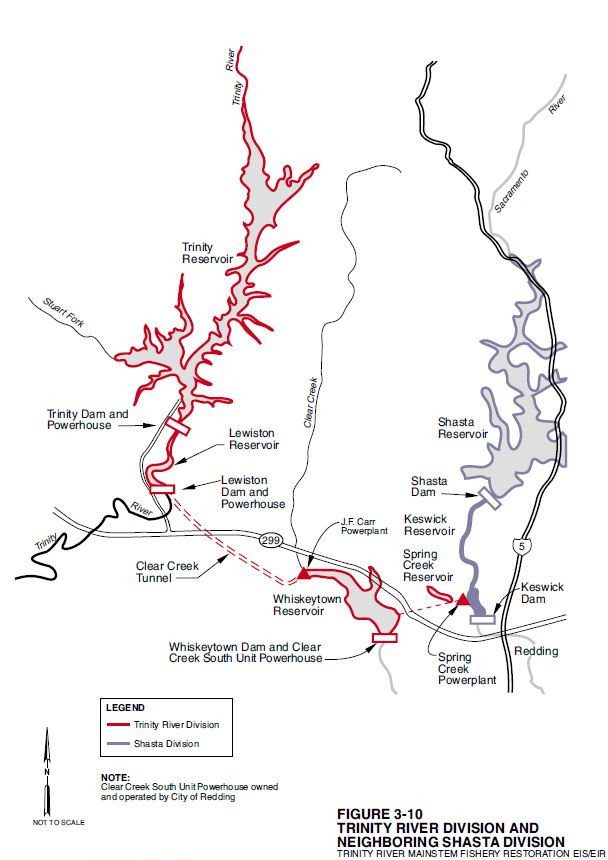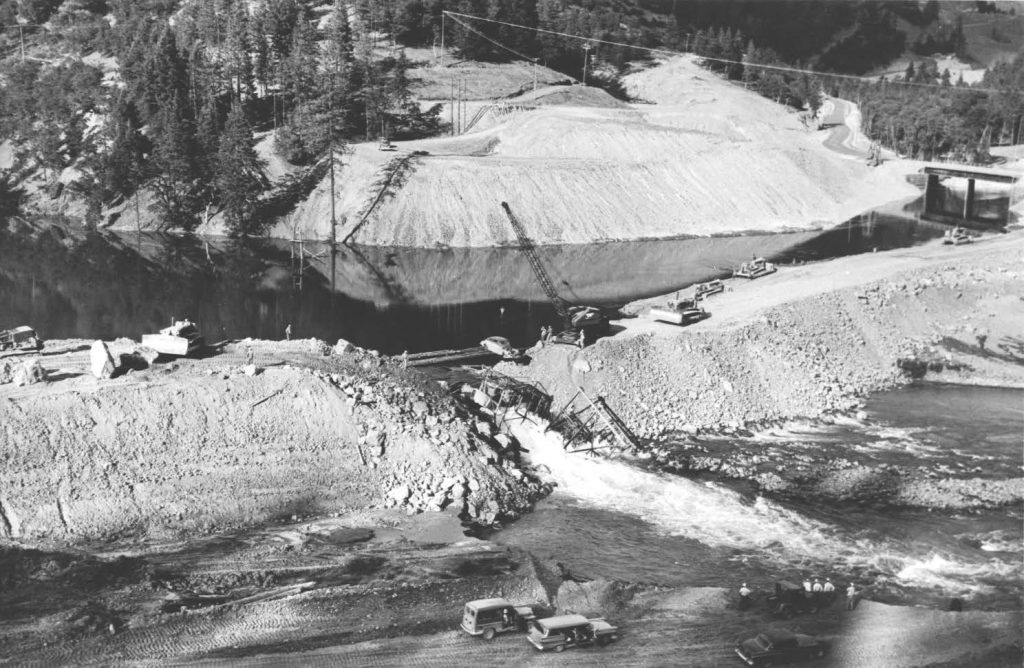DIVERSION FACILITIES AND OPERATIONS
The Trinity River Division (TRD) of the Central Valley Project is composed of the Trinity Dam (a large storage reservoir), Lewiston Dam (which controls the water released into Trinity River) and Clear Creek Tunnel (which transports water from Lewiston Dam into Whiskeytown Lake in the Sacramento River Basin).
AUTHORIZATION, CONSTRUCTION, AND FACILITIES OF THE TRINITY RIVER DIVISION
The Trinity River, located in northwest California, is the largest tributary to the Klamath River. Water export and energy generation from the Trinity River were envisioned as early as 1931, when plans for diverting Trinity River water to the Sacramento River were included as part of the California State Water Plan. These plans were subsequently adopted and refined by the Bureau of Reclamation (Reclamation) and the U.S. Army Corps of Engineers. In 1949, Reclamation released preliminary plans to develop the Trinity River as part of the Central Valley Project.
The TRD was authorized by an act of Congress in 1955 (P.L. 84-386). Section 1 of the act provided for the construction, operation, and maintenance of the TRD. Section 2, however, specifically authorized and directed the Secretary to “…adopt appropriate measures to insure the preservation and propagation of fish and wildlife.”
Congress stated that an average annual supply of 704 TAF (thousand acre-feet) of water, considered surplus to the present and future needs of the Trinity River Basin, could be exported from the Trinity River Basin to the Central Valley “… without detrimental effect on the fishery resources… ” (H.R. Rep. No. 602, 84th Cong., 1st Sess. 4-5 (1955); S. Rep. No. 1154, 84th Cong., 1st Sess. 5 (1955)). Reclamation completed the Trinity River Division in 1964.
Section 2 of the Trinity River Division Act of 1955 specifically authorized the Secretary of the Interior to “…adopt appropriate measures to insure the preservation and propagation of fish and wildlife” of the Trinity River (P.L. 84-386).
FACILITIES
The Shasta (authorized in 1935 and completed in 1945) and Trinity River Divisions of the Central Valley Project store and transfer water resources of the Trinity and northern Sacramento River basins to the Central Valley (see map). Water from the Trinity River Basin is stored, regulated, and diverted through a system of dams, reservoirs, tunnels, and powerplants. The system diverts water south into Clear Creek, the Sacramento River, and the Central Valley of California.
Trinity Dam and Lake: Trinity Dam regulates flows and stores water for various uses. Completed in 1962, Trinity Dam is an earthfill structure 538 feet high with a crest length of 2,450 feet. The dam forms Trinity Lake, which has a storage capacity of 2,448,000 acre-feet. The lake offers recreation facilities for camping, boating, water skiing, swimming, fishing, and hunting.
Trinity Powerplant: Trinity Powerplant at Trinity Dam has two generators with a total capacity of 105,556 kilowatts.
Lewiston Dam and Lake: Lewiston Dam is about 8 miles downstream from Trinity Dam. The dam creates an afterbay to Trinity Powerplant and regulates releases into the Trinity River. Lewiston Dam is an earthfill structure 91 feet high and 754 feet long, forming a reservoir with a storage capacity of 14,660 acre-feet. The trans-basin diversion begins at Lewiston Lake via Clear Creek Tunnel to Whiskeytown Lake.
Judge Francis Carr Powerhouse: Judge Francis Carr Powerhouse, on Clear Creak, has two generators with a total capacity of 141,444 kilowatts.
Whiskeytown Dam and Lake: Located on Clear Creek, Whiskeytown Dam stores Clear Creek runoff and diverted Trinity River flows discharged from Judge Francis Carr Powerhouse. The dam is an earthfill structure 282 feet high with a crest length of 4,000 feet. Whiskeytown Lake has a capacity of 241,100 acre-feet and provides recreation facilities for picnicking, camping, swimming, boating, water skiing, fishing, and hunting. The Spring Creek Tunnel diverts water from Whiskeytown Lake to the Spring Creek Powerhouse and Keswick Dam on the Sacramento River.
Lewiston Powerplant: Lewiston Powerplant at Lewiston Dam has one generator with a capacity of 350 kilowatts.
Trinity River Fish Hatchery: The Trinity River Fish Hatchery (TRFH), operated by the California Department of Fish and Wildlife (CDFW), has a production capacity of roughly 40 million salmonid eggs. It is located immediately downstream from Lewiston Dam. The hatchery was constructed and operated to help mitigate for lost production of habitats upstream from the TRD.
Clear Creek Tunnel: Clear Creek Tunnel, 17.5 feet in diameter and 10.7 miles long, conveys up to 3,200 cfs from Lewiston Lake to Judge Francis Carr Powerhouse and Whiskeytown Lake. It is the conduit for the trans-basin diversion.
RESOURCES FOR THE TRINITY RIVER


